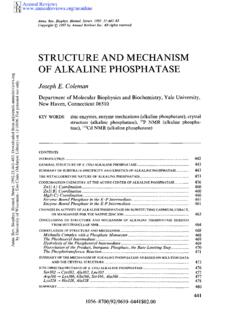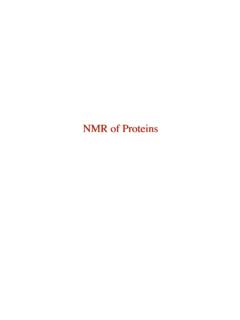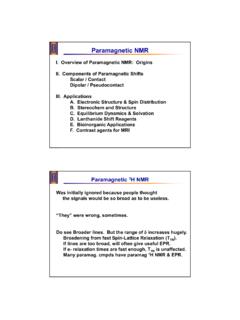Transcription of FTIR Analysis of Protein Structure
1 FTIR Analysis of Protein StructureWarren to Protein structureThe first structures of proteins at an atomic resolution were determined in the late 1950 From that time to the early 1990 s approximately 300 Protein structures were added to the list, primarily using X-ray crystallography. Currently over 20,000 structures are solved,2 some of these using the newer technique of multidimensional nuclear magnetic resonance spectroscopy (NMR). While X-ray crystallography and NMR spectroscopy provide the greatest level of detail about a Protein s Structure , there are many situations where these techniques cannot be applied. Other techniques, such as FTIR, may not provide the same level of structural detail, but can be applied readily to further our understanding of how proteins functionBefore describing the structural information that FTIR spectroscopy provides, a brief introduction to Protein Structure is given.
2 Proteins are linear biological polymers for which the monomeric units are amino acids. (Figure 1). Twenty different amino acids are used to make proteins, each distinguished by the identity of the R group. The amino acids are linked to form a polymer by linking the amino group on one amino acid with the carboxylic acid group on another amino acid to form an amide bond (Figure 2). NCHCOOHHHR amino groupcarboxylic acidgroup"R" groupalpha carbonFigure 1: The Structure of an amino acid; the basic building block for making chemists call the amide bond a peptide bond. When two amino acids are linked together by an amide bond it is called a dipeptide; and when many amino acids are linked together in this fashion it is called a polypeptide. A polypeptide consists of a backbone and sidechains. The backbone comprises the amide nitrogen, the alpha carbon and the carbonyl carbon that are contributed by each amino acid unit.
3 The sidechains comprise the R groups, and dangle from the backbone like charms from a bracelet. 11 Kendrew et al. (1958) Nature 18, Protein Data Bank, Brookhaven National Laboratory, , May 16, 1997 NCHCOOHHHCH3 NCHCOOHHHCH2OH+NCHCOHHCH3 OHCH2 HOHOCHCNHOH+alanineserinea dipeptidewateramide bondFigure 2: Linking two amino acids together by an amide bond to form a are distinguished from one another by the number of amino acids units they contain and by the identity and sequential order of the amino acids. The numbers vary from 50 to hundreds of amino acid units, making the number of possible sequences astronomical. Both the number of amino acids in a Protein and their sequence are genetically determined. Few polypeptides are considered proteins. For a polypeptide to be considered a Protein it must be able to fold into a well-defined 3-dimensional Structure .
4 This is usually a requirement for Protein a Protein folds to form a well defined 3-dimensional Structure it exhibits three levels of Structure : primary, secondary and tertiary. The genetically determined sequence of amino acids is the primary Structure . The primary Structure is often modeled as beads on a string, where each bead represents one amino acid unit. The tertiary Structure might be modeled as a tightly-packed snowball, where each atom in the Protein has a well defined location. Protein folding might be likened to scrunching up the string of beads (the primary Structure ) into a tightly-packed ball (the tertiary Structure ) (Figure 3a). A problem that proteins have in forming a tertiary Structure is that many of the amino acids find themselves on the inside of the tightly-packed ball and no longer in direct contact with water.
5 However, amides like to be exposed to water, because they can form hydrogen bonds with water (Figure 3b). This problem is solved by providing alternative ways for the buried amides to hydrogen bond. Primary among these is to have the amide bonds hydrogen bond to each another (Figure 4).2 HHOHHOOHHNCHCOHCH2 OHCH3 HOCHCNHHO hydrogen bondwith water 3: a. The crudest of Protein folding models: scrunching up a string of beads. b. The hydrogen bonds that form between the amide bond and water. NCHCOHRRHNOCHCNHONCHCOHRRHCOCHCN hydrogen bondsbetween amidesFigure 4: The hydrogen bonds that form between amide bonds buried inside a folded leads to an intermediate level of Protein Structure called secondary Structure . The types of secondary Structure includes the helices and sheets, which allow the amides to hydrogen bond very efficiently with one another.
6 Both are periodic structures. In an -helix the polypeptide backbone is coiled in a right-handed helix where the hydrogen bonding occurs between successive turns of the helix. Figure 5(left) shows a segment of helix from the small Protein bovine pancreatic trypsin inhibitor (BPTI). In sheets, the strands of polypeptide are stretched out and lie either parallel or antiparallel to one another. The hydrogen bonds form between the strands. Figure 5(right) illustrates this with a piece of antiparallel -sheet from BPTI. The other elements of secondary Structure include turns and unordered Structure . turns are sharp turns that connect the adjacent strands in an antiparallel sheet. Unordered strucature is generally a catch-all for regions that do not fall into one of the other categories. These are often loops which form near the surface of proteins and join the other elements of secondary Structure arises when various elements of secondary Structure pack tightly together to form the well-defined 3dimensional Structure .
7 The tertiary Structure of a Protein is defined by the spacial coordinates of all its atoms. held together by favorable interactions between the sidechains. These interactions are weak, which is why proteins are easily denatured by heat and exposure to certain chemicals. The sidechains buried inside a folded Protein are packed tightly together and must interact favorably in order to remain folded. Few 3 Figure 5: Segments of an -helix (left), and a -sheet (right) taken from BPTI. The hydrogens and sidechains have been omitted for clarity. Carbons are black, oxygens are red and nitrogens are blue. The hydrogen bonds between the amide oxygens and nitrogens are shown as dotted the possible polypeptide sequences meet these stringent requirements for folding into the well-defined 3-dimensional structures. Figure 6 shows both a spacefilling and a ribbon model for BPTI.
8 In the space-filling model the atoms are represented by spheres scaled to their true relative sizes, illustrating the tightly packed folded Protein . The ribbon model shows the polypeptide backbone tracing its way through the folded Structure . It highlights the various types of secondary structural information about proteins using FTIR spectroscopyFTIR spectroscopy provides information about the secondary Structure content of proteins, unlike X-ray crystallography and NMR spectroscopy which provide information about the tertiary Structure . FTIR spectroscopy works by shining infrared radiation on a sample and seeing which wavelengths of radiation in the infrared region of the spectrum are absorbed by the sample. Each compound has a characteristic set of absorption bands in its infrared spectrum. Characteristic bands found in the infrared spectra of proteins and polypeptides include the Amide I and Amide II.
9 These arise from the amide bonds that link the amino acids. The absorption associated with the Amide I band leads to stretching vibrations of the C=O bond of the amide, absorption associated with the Amide II band leads primarily to bending vibrations of the N H bond (Figure 7). Because both the C=O and the N H bonds are involved in the hydrogen bonding that takes place between the different elements of secondary Structure , the locations of both the Amide I and Amide II bands are sensitive to the secondary Structure content of a Protein . Studies with proteins of known Structure have been used to correlate systematically the shape of the Amide I band to secondary Structure ,4 The Amide II band, though sensitive 43 Byler, and Susi, H. (1986) Biopolymers 25, Surewicz, and Mantsch, HH. (1988) Biochim. Biophys.
10 Acta 952, secondary Structure content, is not as good a predictor for quantitating the secondary Structure of proteins. One difficulty with analyzing the Amide I band for secondary Structure is that the shifts inFigure 6: Bovine pancreatic trypsin inhibitor. Left, spacefilling model; right, ribbon model. Colors are used to label -helix (purple), sheet (yellow), and loops (white).the Amide I band are small compared to the intrinsic width of the band. Instead of a series of nicely resolved peaks for each type of secondary Structure , one broad lumpy peak is observed (Figure 8a). Several numerical methods are used to increase the apparent resolution of the Amide I band so that estimates can be made of the secondary Structure content. Figure 8b shows results we obtained for the Amide I band of BPTI using the Fourier self-deconvolution method developed by Kauppenin et COHNA mide IvibrationAmide IIvibrationCOHNF igure 7: The vibrations responsible for the Amide I and Amide II bands in the infrared spectra of proteins and polypeptides.















